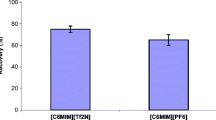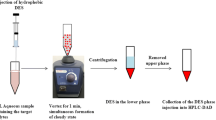Abstract
In traditional dispersive liquid-liquid microextraction procedures, both extraction and dispersive solvents are required, and thus, it increases the consumption of organic solvent. Herein, we reported a CO2-mediated switchable hydrophilicity solvent-based microextraction (SHS-BME) for the determination of bisphenol compounds (BPCs) in complex milk and drink samples. N,N-Dimethylcyclohexylamine was used as a switchable hydrophilicity solvent; it can switch reversibly between one form that is miscible with water and another that forms a biphasic mixture with water, and thus allow extraction of the analytes in a homogeneous phase without dispersive solvent. Several important parameters were screened and optimized by single factor experiments and central composite design as follows: 782 μL of switchable solvent, 375 μL of NaOH solvent, and 1.1:1 switchable solvent/water (v/v). Under the optimized SHS-BME conditions, the limit of detections (LODs) for BPCs in milk, orange juice, and energy drink samples were in the range of 0.27–0.40 μg L−1 for BPE, 0.17–0.30 μg L−1 for BPA, and 0.50–0.67 μg L−1 for BPB, respectively, and the extraction recoveries for BPCs were in the range of 79.5–103.4% in milk, of 84.5–97.5% in orange juice, and of 91.9–101.2% in energy drinks. The precision of the method, based on relative standard deviations (RSDs), ranged from 1.7 to 4.8% and from 2.1 to 5.7% for intra-day and inter-day comparisons, respectively. In total, this SHS-BME method possesses many advantages, such as high extraction recovery and high detection sensitivity (low LODs and RSDs), no requirement of dispersive solvent, simple operational procedure, reducing the pretreatment time and workload, and so on. Therefore, it has a great potential application value for detection of trace BPCs in routine food tests.







Similar content being viewed by others
References
Alabi A, Caballero-Casero N, Rubio S (2014) Quick and simple sample treatment for multiresidue analysis of bisphenols, bisphenol diglycidyl ethers and their derivatives in canned food prior to liquid chromatography and fluorescence detection. J Chromatogr A 1336:23–33
Authority EFS (2015) Scientific opinion on the risks to public health related to the presence of bisphenol A (BPA) in foodstuffs. EFSA J 13:3978–3990
Azzouz A, Souhail B, Ballesteros E (2010) Continuous solid-phase extraction and gas chromatography-mass spectrometry determination of pharmaceuticals and hormones in water samples. J Chromatogr A 1217:2956–2963
Durelle J, Vanderveen JR, Quan Y, Chalifoux CB, Kostin JE, Jessop PG (2015) Extending the range of switchable hydrophilicity solvents. Phys Chem Chem Phys 17:5308–5313
Ezzodin M, Abdi K, Lami N (2016) Development of air assisted liquid phase microextraction based on switchable-hydrophilicity solvent for the determination of palladium in environmental samples. Talanta 153:247–252
Faraji M, Noorani M, Sahneh BN (2016) Quick, easy, cheap, effective, rugged, and safe method followed by ionic liquid-dispersive liquid–liquid microextraction for the determination of trace amount of bisphenol A in canned foods. Food Anal Method. 10:764–772
Gao M, Wang HL, Ma MP, Zhang YN, Yin XH, Dahlgren RA (2015) Optimization of a phase separation based magnetic-stirring salt-induced liquid-liquid microextraction method for determination of fluoroquinolones in food. Food Chem 175:181–188
Gao JJ, Wang H, Qu JG, Wang HL, Wang XD (2017) Development and optimization of a naphthoic acid-based ionic liquid as a “non-organic solvent microextraction” for the determination of tetracycline antibiotics in milk and chicken eggs. Food Chem 215:138–148
Guo Z, Feng Y, He S, Qu M, Chen H, Liu H et al (2012) Smart single-walled carbon nanotubes. Adv Mater 25:584–590
Jessop PG, Subramaniam B (2007) Gas-expanded liquids. Chem Rev 107:2666–2694
Jessop PG, Heldebrant DJ, Li X, Eckert CA, Liotta CL (2005) Green chemistry: reversible nonpolar-to-polar solvent. Nature 436:1102–1102
Jessop PG, Phan L, Carrier A, Robinson S, Durr CJ, Harjani JR (2010) A solvent having switchable hydrophilicity. Green Chem 12:809–814
Jessop PG, Kozycz L, Rahami ZG, Scheonmakers D, Boyd AR, Wechsler D et al (2011) Tertiary amine solvents having switchable hydrophilicity. Green Chem 13:619–623
Kamalabadi M, Mohammadi A, Alizadeh N (2016) Polypyrrole nanowire as an excellent solid phase microextraction fiber for bisphenol A analysis in food samples followed by ion mobility spectrometry. Talanta 156-157:147–153
Lang IA, Galloway TS, Scarlett A, Henley WE, Depledge M, Wallace RB, Melzer D (2008) Association of urinary bisphenol A concentration with medical disorders and laboratory abnormalities in adults. J Am Med Assoc 300:1303–1310
Lasarte-Aragones G, Lucena R, Cardenas S, Valcarcel M (2015) Use of switchable solvents in the microextraction context. Talanta 131:645–649
Liu JY, Lu WH, Liu HT, Wu XQ, Li JH, Chen LX (2016) Dispersive liquid-liquid microextraction for four phenolic environmental estrogens in water samples followed by determination using capillary electrophoresis. Electrophoresis 10:1–7
Magali K, Tiele MR, Manoel LM, Osmar DP, Martha BA, Renato Z (2015) Optimization by central composite design of a modified quEChERS method for extraction of pesticide multiresidue in sweet pepper and analysis by ultra-high-performance liquid chromatography-tandem mass spectrometry. Food Anal Meth 8:728–739
Michalowicz J (2014) Bisphenol A-sources, toxicity and biotransformation. Environ Toxicol Pharmacol 37:738–758
Mnh R, Yahaya N, Saad B, Kamaruzaman S, Nsm H (2017) Rapid ultrasound assisted emulsification micro-solid phase extraction based on molecularly imprinted polymer for HPLC-DAD determination of bisphenol A in aqueous matrices. Talanta 171:242–249
Phan L, Chiu D, Heldebrant DJ, Huttenhower H, John E, Li X, Pollet P, Wang R, Eckert CA, Liotta CL, Jessop PG (2008) Switchable solvents consisting of amidine/alcohol or guanidine/alcohol mixtures. Ind Eng Chem Res 47:539–545
Rajabi M, Asemipour S, Barfi B, Jamali MR, Behzad M (2014) Ultrasound-assisted ionic liquid based dispersive liquid-liquid microextraction and flame atomic absorption spectrometry of cobalt, copper, and zinc in environmental water samples. J Mol Liq 194:166–171
Russo G, Barbato F, Grumetto L (2016) Development and validation of a LC-FD method for the simultaneous determination of eight bisphenols in soft drinks. Food Anal Methods 9:1–9
Sadeghi M, Nematifar Z, Fattahi N, Pirsaheb M, Shamsipur M (2016) Determination of bisphenol A in food and environmental samples using combined solid-phase extraction-dispersive liquid-liquid microextraction with solidification of floating organic drop followed by HPLC. Food Anal Method 9:1814–1824
Samori C, Torri C, Samori G, Fabbri D, Galletti P, Guerrini F et al (2010) Extraction of hydrocarbons from microalga Botryococcus braunii with switchable solvents. Bioresour Technol 101:3274–3279
Sarode DB, Attarde SB, Varsha S, ETS M (2015) Liquid phase extraction of Cd2+, Ni2+, Pb2+ and Zn2+ by N-benzoyl-nphenylhydroxylamine (BPA) from environmental waste samples. Curr Anal Chem 11:36–43
Tan XW, Song YX, Wei RP, Gu-Yang YI (2012) Determination of trace bisphenol A in water using three-phase hollow fiber liquid-phase microextraction coupled with high performance liquid chromatography. Chin J Anal Chem 40:1409–1414
Tan F, Cong LC, Li XN, Zhao Q, Zhao HX, Quan X, Chen JW (2016) An electrochemical sensor based on molecularly imprinted polypyrrole/graphene quantum dots composite for detection of bisphenol A in water samples. Sens Actua B 233:599–606
Vanderveen JR, Durelle J, Jessop PG (2014) Design and evaluation of switchable-hydrophilicity solvents. Green Chem 16:1187–1197
Wu X, Li XR, Zhu XL, He CY, Wang Q, Liu SR (2017) Dummy molecularly imprinted magnetic nanoparticles for dispersive solid-phase extraction and determination of bisphenol A in water samples and orange juice. Talanta 162:57–64
Yang Y, Yu J, Yin J, Shao B, Zhang J (2014) Molecularly imprinted solid-phase extraction for selective extraction of bisphenol analogues in beverages and canned food. J Agric Food Chem 62:11130–11137
Yilmaz E, Soylak M (2015) Switchable solvent based liquid phase microextraction of copper(II): optimization and application to environmental samples. J Anal Spectrom 30:1629–1635
Zhao RS, Wang X, Yuan JP, Zhang LL (2009) Solid-phase extraction of bisphenol A, nonylphenol and 4-octylphenol from environmental water samples using microporous bamboo charcoal and their determination by HPLC. Microchim Acta 165:443–447
Acknowledgements
The authors acknowledge the correction of English grammar by Professor Randy A. Dahlgren, who is employed in the University of California-Davis, CA 95616, US.
Funding
This study was funded by the National Natural Science Foundation of China (21577107 and 21377100).
Author information
Authors and Affiliations
Corresponding authors
Ethics declarations
Conflict of Interest
Xuran Wang declares that she has no conflict of interest. Ming Gao declares that he has no conflict of interest. Zhanen Zhang declares that he has no conflict of interest. Haidong Gu declares that he has no conflict of interest. Tingting Liu declares that she has no conflict of interest. Nana Yu declares that she has no conflict of interest. Huili Wang declares that she has no conflict of interest. Xuedong Wang has received research grants from the National Natural Science Foundation of China (21577107).
Ethical Approval
This article does not contain any studies with human participants or animals performed by any of the authors.
Informed Consent
Not applicable.
Electronic Supplementary Material
Supplementary Figure 1
(GIF 30 kb)
Supplementary Figure 2
(GIF 66 kb)
ESM 1
(DOCX 12.9 kb)
ESM 2
(DOCX 14.2 kb)
Rights and permissions
About this article
Cite this article
Wang, X., Gao, M., Zhang, Z. et al. Development of CO2-Mediated Switchable Hydrophilicity Solvent-Based Microextraction Combined with HPLC-UV for the Determination of Bisphenols in Foods and Drinks. Food Anal. Methods 11, 2093–2104 (2018). https://doi.org/10.1007/s12161-018-1187-0
Received:
Accepted:
Published:
Issue Date:
DOI: https://doi.org/10.1007/s12161-018-1187-0




